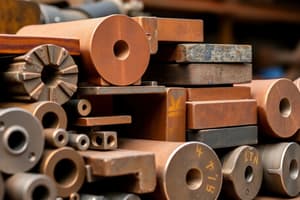Podcast
Questions and Answers
What property describes a material's ability to withstand repeated applications of stress?
What property describes a material's ability to withstand repeated applications of stress?
- Rigidity
- Endurance (correct)
- Ductility
- Toughness
What is the maximum carbon content in low carbon steel?
What is the maximum carbon content in low carbon steel?
- 0.5%
- 0.8%
- 0.15%
- 0.3% (correct)
Which steel category is used primarily for high-tensile pipes and tubes?
Which steel category is used primarily for high-tensile pipes and tubes?
- Alloy steel
- High carbon steel
- Medium carbon steel (correct)
- Low carbon steel
Which of the following is not a characteristic of high carbon steels?
Which of the following is not a characteristic of high carbon steels?
What is a characteristic of thermoplastic polymers?
What is a characteristic of thermoplastic polymers?
What is the main purpose of adding chromium to alloy steels?
What is the main purpose of adding chromium to alloy steels?
Which of these ceramics is primarily based on silica?
Which of these ceramics is primarily based on silica?
Which product is made from medium carbon steel with carbon content from 0.5% to 0.8%?
Which product is made from medium carbon steel with carbon content from 0.5% to 0.8%?
Which type of steel has the highest carbon content among the options given?
Which type of steel has the highest carbon content among the options given?
How do the densities of most ceramics compare to metals and polymers?
How do the densities of most ceramics compare to metals and polymers?
What characteristic does the addition of nickel provide to alloy steels?
What characteristic does the addition of nickel provide to alloy steels?
Which of the following types of polymers cannot be reshaped after curing?
Which of the following types of polymers cannot be reshaped after curing?
What is a common use of thermoplastic polymers?
What is a common use of thermoplastic polymers?
What is a primary reason for selecting a particular material for a specific application?
What is a primary reason for selecting a particular material for a specific application?
Which property contributes to metals' ability to absorb energy effectively?
Which property contributes to metals' ability to absorb energy effectively?
Which of the following is a characteristic exclusive to ferrous metals?
Which of the following is a characteristic exclusive to ferrous metals?
What is one advantage of using alloyed metals over pure metals in engineering applications?
What is one advantage of using alloyed metals over pure metals in engineering applications?
Which of the following metals would be categorized as nonferrous?
Which of the following metals would be categorized as nonferrous?
If a designer needs a material that combines electrical conductivity with high strength, which should be prioritized?
If a designer needs a material that combines electrical conductivity with high strength, which should be prioritized?
What defines an alloy?
What defines an alloy?
Why is cost and availability an important factor in material selection?
Why is cost and availability an important factor in material selection?
What does Hooke's Law describe relating to materials?
What does Hooke's Law describe relating to materials?
What is true strain defined as?
What is true strain defined as?
Which property of a material allows it to return to its original dimensions when the load is removed?
Which property of a material allows it to return to its original dimensions when the load is removed?
What occurs during the strain hardening phase of a true stress-strain curve?
What occurs during the strain hardening phase of a true stress-strain curve?
Which of the following is a measure of a material's ability to absorb mechanical energy?
Which of the following is a measure of a material's ability to absorb mechanical energy?
What does the term 'hardness' refer to in mechanical properties?
What does the term 'hardness' refer to in mechanical properties?
Which mechanical property is characterized by the material's inability to deform significantly before fracture?
Which mechanical property is characterized by the material's inability to deform significantly before fracture?
What is the correct formula for calculating true stress?
What is the correct formula for calculating true stress?
What characterizes the primary phase in composite materials?
What characterizes the primary phase in composite materials?
Which of the following is NOT a type of matrix in composite materials?
Which of the following is NOT a type of matrix in composite materials?
What is a common example of a laminar composite structure?
What is a common example of a laminar composite structure?
What function does the secondary phase serve in composite materials?
What function does the secondary phase serve in composite materials?
Which composite material is made with a ceramic matrix?
Which composite material is made with a ceramic matrix?
Which of the following descriptions fits a sandwich composite structure?
Which of the following descriptions fits a sandwich composite structure?
What is a common application of composite materials in automotive design?
What is a common application of composite materials in automotive design?
How do cemented carbides exemplify composite materials?
How do cemented carbides exemplify composite materials?
Flashcards are hidden until you start studying
Study Notes
Materials in Manufacturing
- The properties of engineering materials are crucial for design and manufacturing engineers.
- Proper material selection takes into account: material properties, processing methods, cost, and availability.
Classification of Engineering Materials
- Engineering materials can be classified into metals, ceramics, polymers, and composites.
Metals
- Metals are strong, stiff, and tough, making them suitable for structural applications.
- They are good conductors of heat and electricity.
- Some metals possess magnetic properties.
- They are typically ductile.
Classification of Metals
- Ferrous Metals: Include steels and cast iron, which contain iron as the primary element.
- Nonferrous Metals: Examples include Aluminum, magnesium, copper, nickel, and titanium. These metals don't contain iron.
Pure Metals and Alloys
- Some metals are used in their pure form (e.g., gold, silver, copper).
- Many engineering applications use alloys, which enhance the properties of pure metals.
- Alloy: A combination of two or more elements, at least one being a metal, which improves strength, hardness, and other properties.
Material Properties and Selection
- When selecting a material, consider its properties under expected operating conditions.
- Mechanical Properties: These characteristics determine how a material responds to applied loads.
- Elasticity: Ability of a material to return to its original shape after removing an applied load.
- Hooke's Law: Describes the relationship between stress and strain, with "E" representing the modulus of elasticity, a measure of the material's stiffness.
- True Stress: Force divided by the current deformed area of a test specimen.
- True Strain: Defined as the natural logarithm of the ratio of the instantaneous length to the initial length.
Mechanical Properties
- Hardness: A material's resistance to abrasion or indentation.
- Brittleness: The tendency of a material to fracture with little or no deformation.
- Strength: The material's ability to resist an applied force measured in stress units.
- Toughness: The material's capacity to absorb energy, like shocks and blows.
- Malleability: The ability of a material to withstand significant plastic compressive deformation.
- Plasticity: The characteristic that allows materials to undergo permanent shape changes without cracking.
- Stiffness: The resistance of a material to any type of deformation.
- Resilience: The material's capability to store mechanical energy.
- Fatigue: Failure of a material caused by repeated alternating stresses.
- Endurance: The material's ability to withstand repeated application of a load.
Steel
- An iron alloy containing 0.025% to 2.11% carbon by weight.
- Plain carbon steels can be categorized into low, medium, and high carbon steels based on their carbon content.
Low Carbon Steel
- Contains up to 0.3% carbon.
- Dead mild steel: 0.1 to 0.15% carbon. Used in car bodies, rivets, and pipes due to its ductility and softness.
- Mild steel: 0.15% to 0.3% carbon. Available in various forms and used in bolts, nuts, chains, and bridges.
Medium Carbon Steels
- 0.3% to 0.8% carbon.
- Used in applications like drop-hammers, die blocks, leaf springs, and high-tensile pipes and tubes.
High Carbon Steels
- Above 0.8% carbon.
- Harder, less ductile, and more expensive than low and medium carbon steels.
- Used for springs, cutting tools, and forming dies.
Alloy Steels
- Nickel: Refines the grain and strengthens steel.
- Chromium: Improves the corrosion resistance of steel.
Ceramics
- Mostly inorganic compounds like oxides, carbides, nitrides, and silicates.
- Modern ceramics: Examples include alumina (Al2O3).
- Glasses: Primarily based on silica (SiO2).
Physical Properties of Ceramics
- Density: Generally lighter than metals but heavier than polymers.
- Melting Temperatures: Higher than most metals. Some ceramics decompose instead of melting.
- Electrical and Thermal Conductivity: Usually lower than metals, leading to insulating properties in some cases.
- Thermal Expansion: Lower than metals.
Polymers
- Compounds composed of repeating structural units called mers.
- Organic chemicals, mostly based on carbon.
- Classified into thermoplastics, thermosetting polymers, and elastomers.
Thermoplastic Polymers
- Can withstand multiple heating and cooling cycles without changing their molecular structure.
- Examples: polyethylene, polyvinylchloride, polystyrene, and nylon.
Thermosetting Polymers
- Cannot be reheated after initial molding.
- Examples: epoxies and certain polyesters.
Elastomers
- Show significant elastic behavior.
- Examples: Rubber and other materials displaying rubbery properties.
Polymer Products
- Thermoplastics: Molded and extruded items, films, sheets, packaging materials, paints, and varnishes.
- Thermosetting Polymers: Pot handles, electrical switch covers, plywood adhesives, molded parts, printed circuit boards, and fiber-reinforced plastics.
Composites
- Combine two or more materials with distinct properties to achieve superior overall performance.
- Usually consist of particles or fibers of one phase dispersed in a second phase.
- Examples: Cemented carbides (WC with Co binder), rubber with carbon black.
Classification of Composites
- Matrix Phase: The primary material in which the reinforcing phase is embedded.
- Reinforcing Phase: The embedded phase, often fibers, particles, or other geometries that provide added properties.
Composite Types
- Metal Matrix Composites (MMCs): Mixtures of ceramics and metals, such as cemented carbides.
- Ceramic Matrix Composites (CMCs): Contain materials like Al2O3 and SiC reinforced with fibers.
- Polymer Matrix Composites (PMCs): Polymer resins embedded with fillers or reinforcing agents.
Laminar Composite Structure
- Two or more layers bonded together for increased strength and other properties.
- Examples: Plywood, automotive tires, fiber-reinforced plastic panels, printed circuit boards, and windshield glass.
Studying That Suits You
Use AI to generate personalized quizzes and flashcards to suit your learning preferences.





